AMD Radeon PRO WX 4100 Compute Related Benchmarks
As we move along with the GPU testing we felt it was time to clean up our database and results in graphs, we have dropped the Silent and OC results for each card and kept the fresh out of box numbers. Doing so made our graphs much easier to read, many users here at STH do not run cards in those configurations or simply cannot do so in Linux based systems so this was warranted. We still have our test numbers and might revisit those settings later on.
Uses cases for the AMD Radeon PRO WX 4100 would not be for high-end graphics, heavy compute tasks or major CAD/Render work, we do not expect to see benchmark results above the bottom of our charts, but the AMD Radeon PRO WX 4100 handles light-duty tasks fine. Also, our benchmarks are run on a 4K display which the AMD Radeon PRO WX 4100 can handle for general purpose work, lower screen resolutions might be better for more demanding workloads.
Geekbench 4
Geekbench 4 measures the compute performance of your GPU using image processing to computer vision to number crunching.
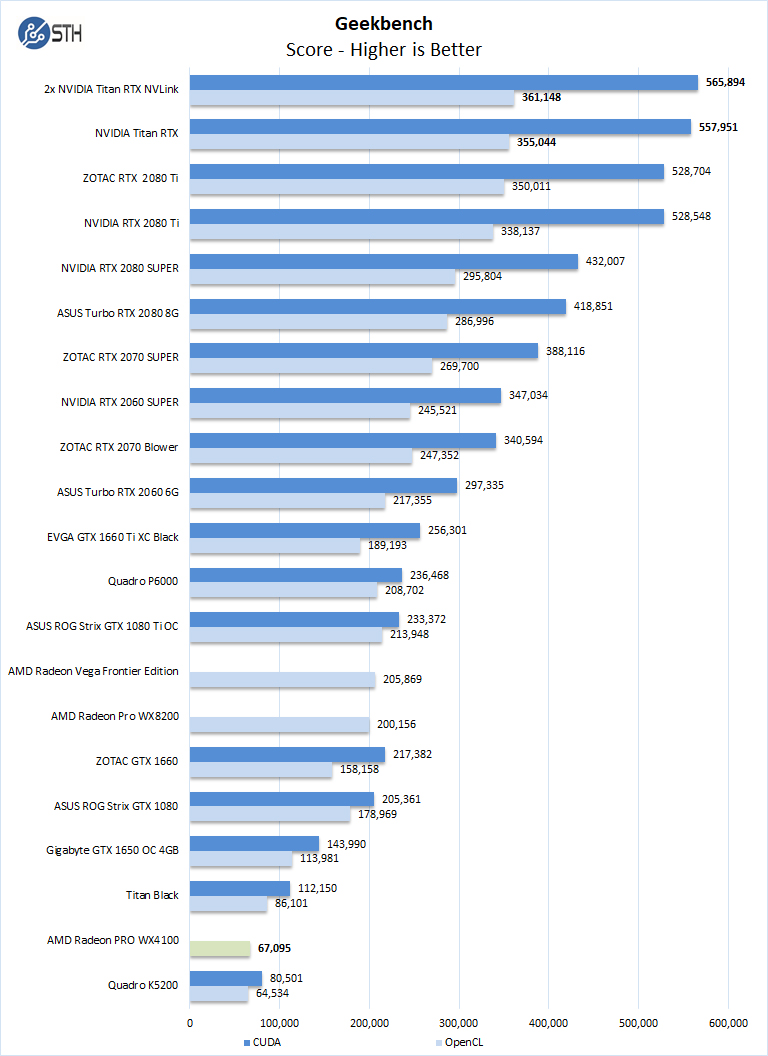
Our first compute benchmark we see the AMD Radeon PRO WX 4100 achieve results between the NVIDIA Titan Black and the Quadro K5200 for OpenCL workloads. We expect to see this trend throughout our benchmarks. CUDA performance is, of course, not applicable because this is an AMD card.
LuxMark
LuxMark is an OpenCL benchmark tool based on LuxRender.
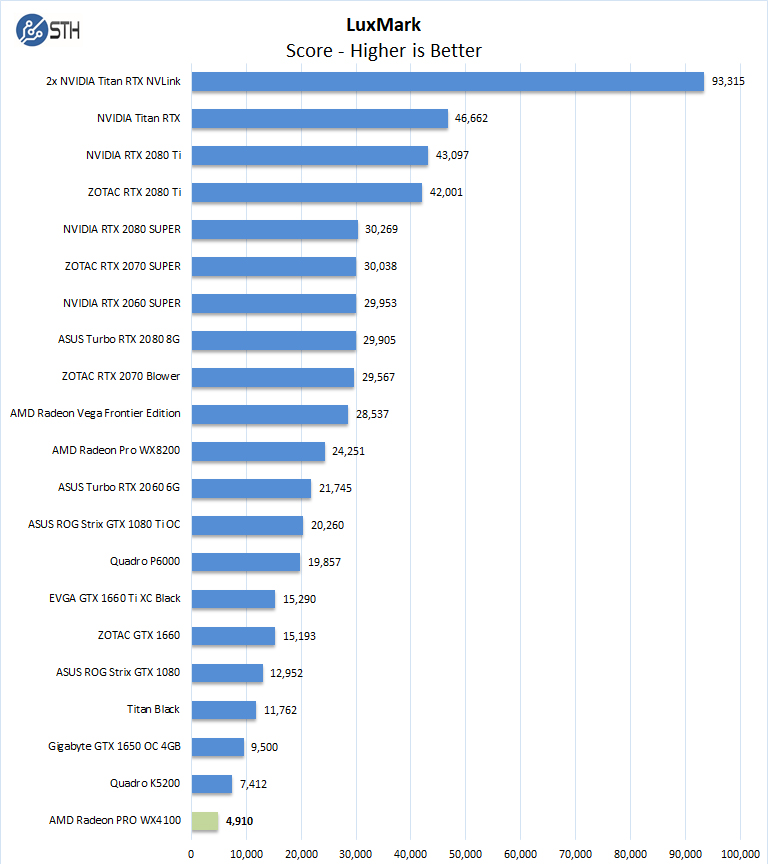
With LuxMark results, we find the AMD Radeon PRO WX 4100, falls to the bottom of the chart, most modern GPU’s are able to achieve these results with ease.
AIDA64 GPGPU
These benchmarks are designed to measure GPGPU computing performance via different OpenCL workloads.
- Single-Precision FLOPS: Measures the classic MAD (Multiply-Addition) performance of the GPU, otherwise known as FLOPS (Floating-Point Operations Per Second), with single-precision (32-bit, “float”) floating-point data.
- Double-Precision FLOPS: Measures the classic MAD (Multiply-Addition) performance of the GPU, otherwise known as FLOPS (Floating-Point Operations Per Second), with double-precision (64-bit, “double”) floating-point data.
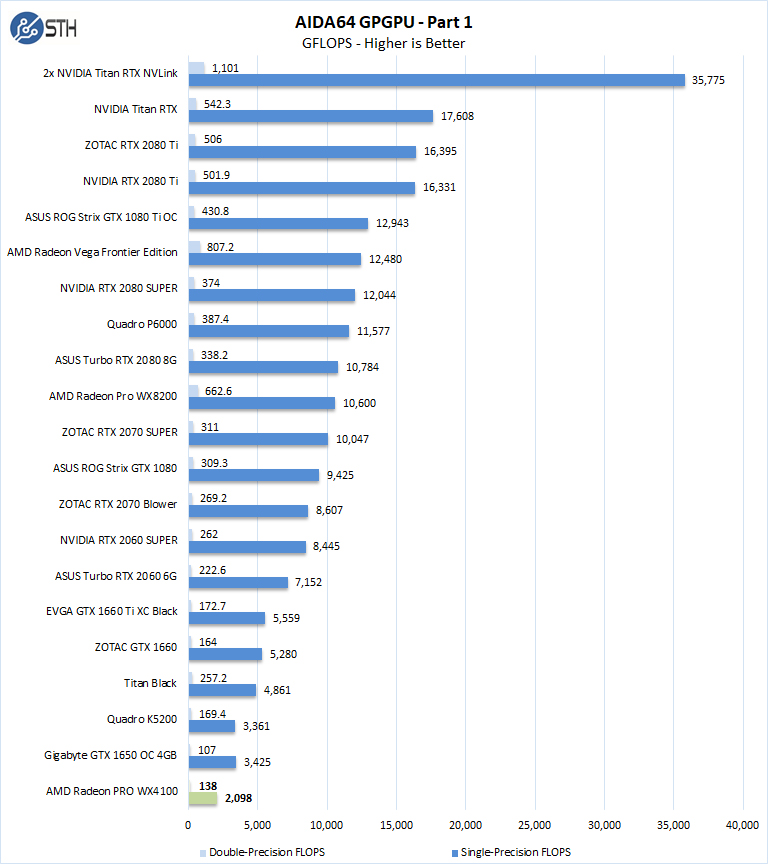
The next set of benchmarks from AIDA64 are:
- 24-bit Integer IOPS: Measures the classic MAD (Multiply-Addition) performance of the GPU, otherwise known as IOPS (Integer Operations Per Second), with 24-bit integer (“int24”) data. This particular data type defined in OpenCL on the basis that many GPUs are capable of executing int24 operations via their floating-point units.
- 32-bit Integer IOPS: Measures the classic MAD (Multiply-Addition) performance of the GPU, otherwise known as IOPS (Integer Operations Per Second), with 32-bit integer (“int”) data.
- 64-bit Integer IOPS: Measures the classic MAD (Multiply-Addition) performance of the GPU, otherwise known as IOPS (Integer Operations Per Second), with 64-bit integer (“long”) data. Most GPUs do not have dedicated execution resources for 64-bit integer operations, so instead, they emulate the 64-bit integer operations via existing 32-bit integer execution units.
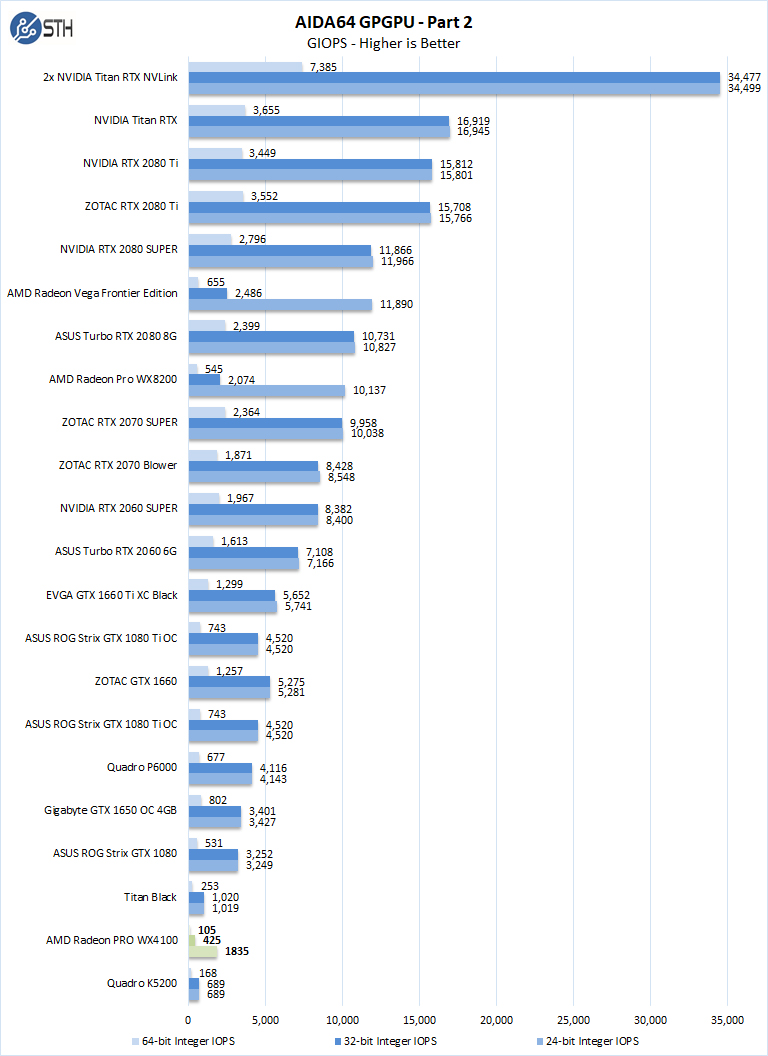
Our trend is going to continue, but we still wanted to show the integer and floating-point performance here.
hashcat64
Hashcat64 is a password cracking benchmarks that can run an impressive number of different algorithms. We used the windows version and a simple command of hashcat64 -b. Out of these results we used five results to the graph. Users who are interested in hashcat can find the download here.
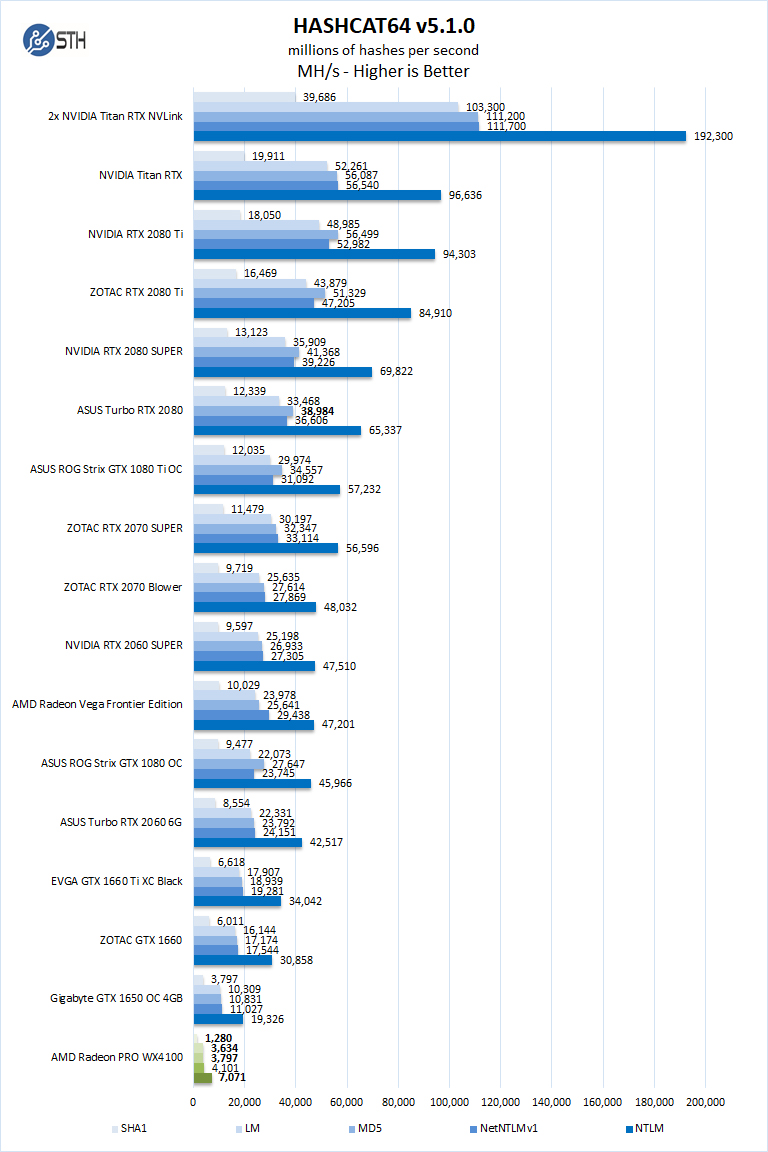
This is probably not the card you want to deploy, even in quantity, for brute force crypto work.
SPECviewperf 13
SPECviewperf 13 measures the 3D graphics performance of systems running under the OpenGL and Direct X application programming interfaces.
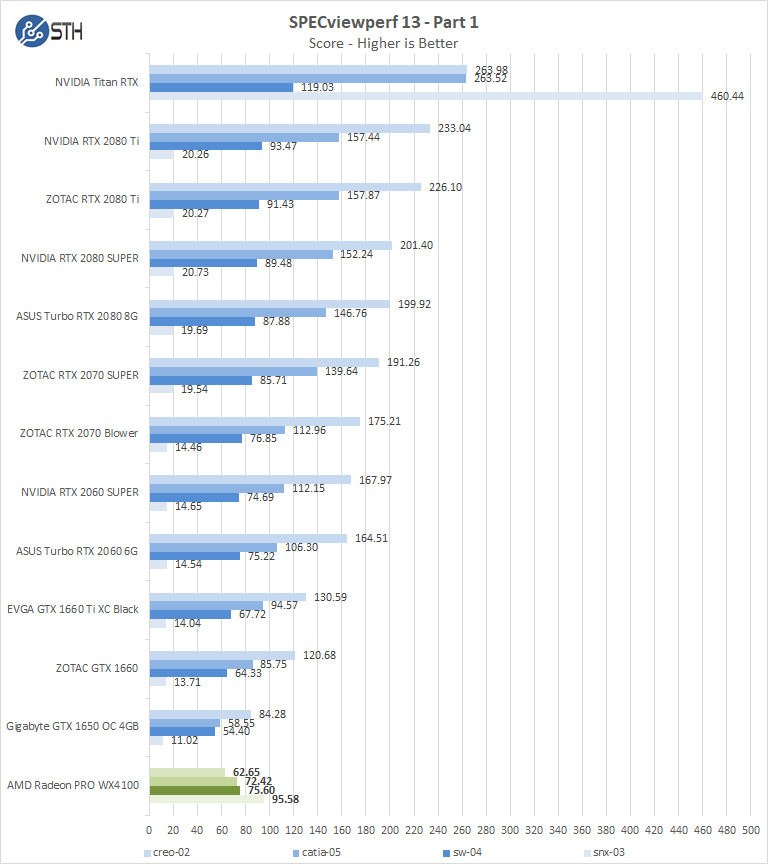
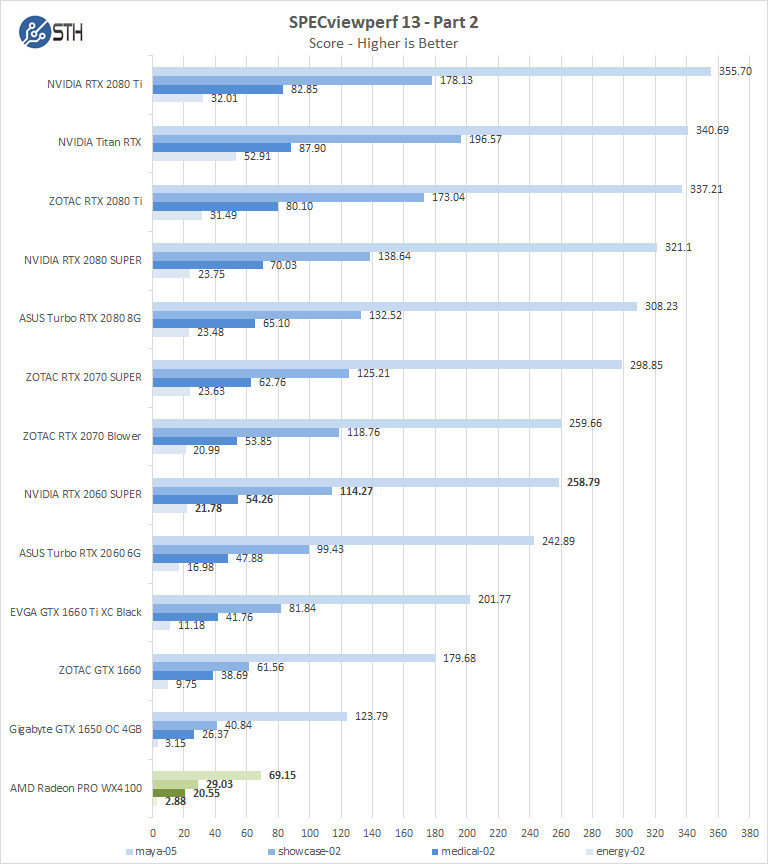
This is an interesting result since the AMD Radeon PRO WX 4100 is not too far from the Gigabyte GeForce GTX 1650 OC results. We often see these cards installed in workstations as well, so this result is a positive sign.
Let us move on and start our new tests with rendering-related benchmarks.
AMD Radeon PRO WX 4100 Rendering Related Benchmarks
Next, we wanted to get a sense of the rendering performance of the AMD Radeon PRO WX 4100. We are going to omit several of our render benchmarks from our testing this round since they are CUDA-only GPU rendering platforms.
MAXON Cinema4D 3D
ProRender is an OpenCL based GPU renderer which is available in MAXON’s Cinema4D 3D animation software. A fully functional 42-day trial version is available for downloaded from the MAXON website here. Note: Even after expiration, the trial can still be used to measure render times.
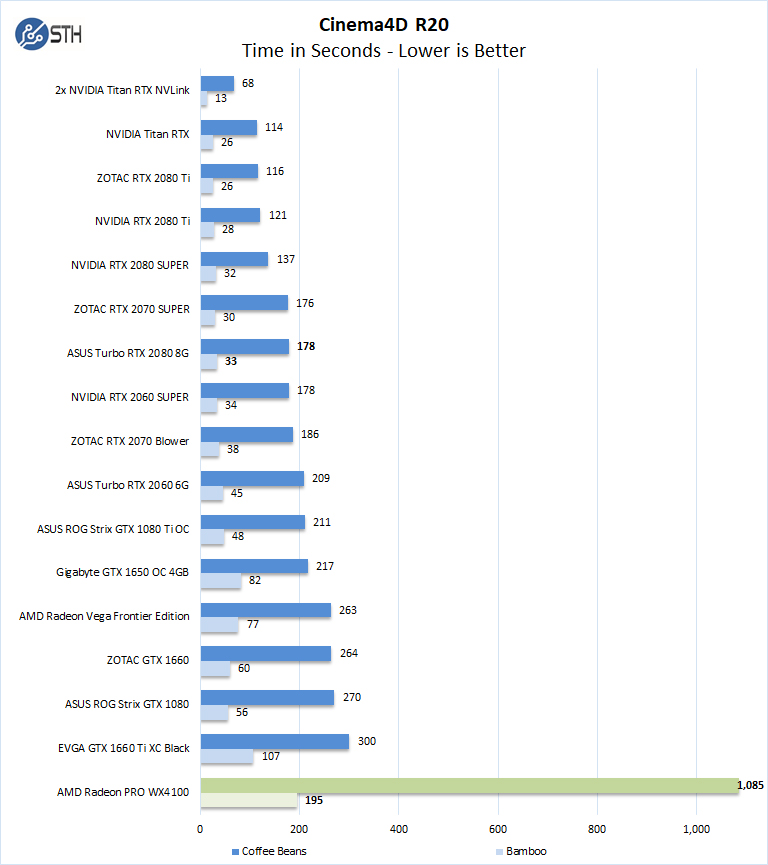
In this test, the AMD Radeon PRO WX 4100 card is not fast. The Bamboo benchmark takes over 3x the time of the next slowest card in our data set.
Next, we will have 3DMark results before moving onto power consumption, thermals, and our final thoughts.




Good you review these low power cards too! We are using the WX3100 in workstations that need to prepare and test data analysis tasks with small sample datasets. The full dataset analysis is done on a heavy cluster, but for proof of concept work these cards are a gem! Low power, silent workstations.
Would these work well in a Htpc for say light plex transcodes no outside streams
@Jason H Goodliffe for plex specifically you’ll want an nvidia card as opposed to a radeon thanks to nvenc. The P620 is a pascal based card at the same pricepoint of the WX4100 but if you want room for more than 2 transcodes(the p620 only supports 2 concurrent sessions) you’ll want to look up the stack at the p2000 which can be found for ~400 and supports “unlimited” concurrent sessions(there is a limit in reality but I’ve heard of people passing 9 encodes on one card so I don’t know what the practical limit on a p2000 is)
Rumor has it William may have a Quadro P620 as well.
I like that rumor, I just built a system with 2 p600’s for an 8 display solution can’t wait to see the p620.
p620 same price as wx4100, which one should i chose?
i using autocad and intericad – 2d and 3d rendering.
I already have the P620 yet I got this card only because this card is compatible with modern Mac OS (Big Sur, Ventura). To be very specific, this is a great card for Hacintosh PC build. Multi-monitor setup is exactly what I am looking for. Extra 2GB of memory of P620 is much appreciated.